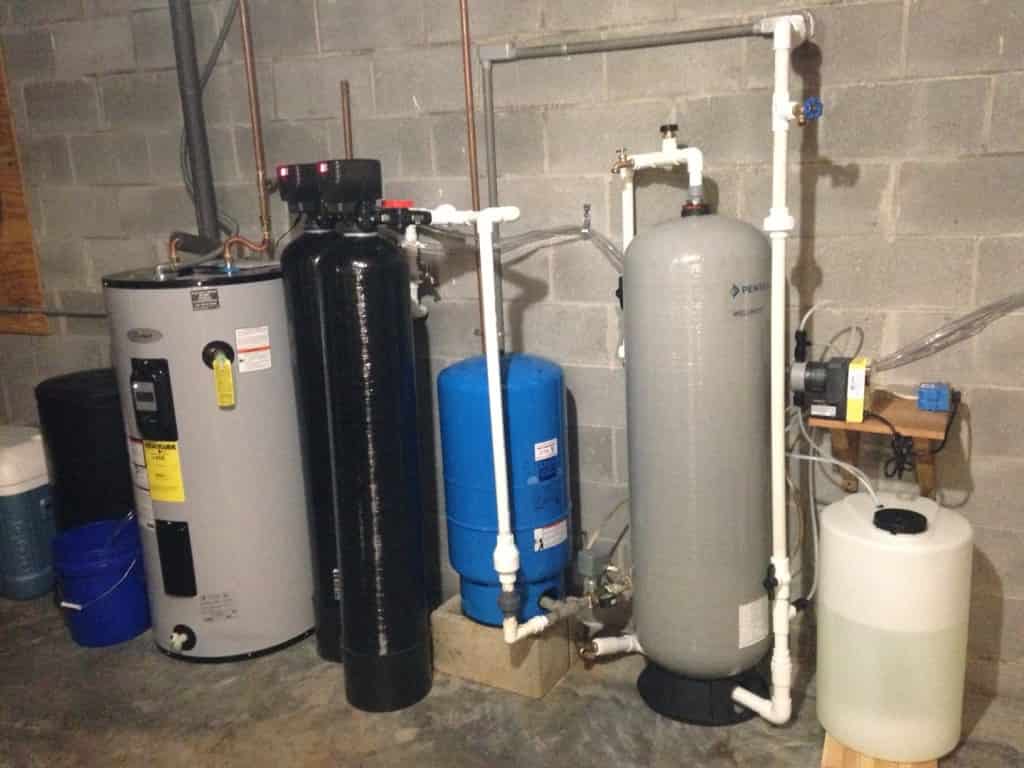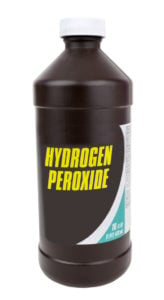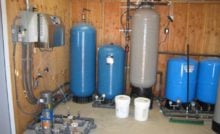Hydrogen Peroxide for Well Water Treatment: How to Eliminate Odors with Peroxide


Podcast: Play in new window | Download
Subscribe: RSS
How to Eliminate Odors and Freshen Well Water with Hydrogen Peroxide


Four years or so ago, I posted a post on our blog called “Eliminate Well Water Odors: Four Reasons Why Hydrogen Peroxide Water Treatment Is Best.” Many folks have called and emailed us regarding that article and asked about peroxide systems. I wanted to do a podcast episode explaining why peroxide can often be the best option to kill sulfur odor in your well water!
Well Water Odor
If your well water smells like rotten eggs, you’re not alone. Well water odor is a common problem. Many homeowners on well water battle the stinky hydrogen sulfide.
Rotten-egg hydrogen sulfide-laden water has an objectionable odor, but higher concentrations can be dangerous to health. It’s corrosive to plumbing fixtures and appliances because when hydrogen sulfide is formed and gets into your groundwater, you get sulfuric acid.
That makes the water tarnish fixtures and eat up the pipes. This unique rotten egg odor, hydrogen sulfide, is usually found in hot and cold water and can sometimes be worse in your water heater and hot water.
Historically, aeration has been a common way to get rid of smelly water. Chlorine, however, has some undesirable byproducts and can leave a chlorine taste and odors if not properly set upright.
Also, if the pH of your water is over 7.5 to 8, in other words, if you have alkaline water, then you have to use a lot of chlorine to get it to kill the hydrogen sulfide rotten egg odor. We found, as a lot of other folks do, that hydrogen peroxide does a better job.
Aeration can work well, but if you have iron or sulfur bacteria present, sometimes the bacteria can still create odors after your aeration system. In other words, it can develop in your water heater and plumbing system.
Aeration systems can also be more expensive to set up than peroxide injection. If used in the right concentration, peroxide can kill these iron-sulfur-laden bacteria.
4 Reasons Hydrogen Peroxide Works
- It works faster than chlorine, so often, no contact tank is required
- Unlike chlorine, the peroxide will not leave a chemical residue or chemical by-products after it’s injected into the water.
- Peroxide works over a wider pH range
- Does not affect taste; it often improves the taste compared to chlorination
Over the last 10 years or so, hydrogen peroxide has become a preferred method of treating odor by many well water contractors and water treatment specialists across the U.S. and Canada.
Peroxide and Chlorine
So you might ask: Hey, if peroxide is so great, would you ever use chlorination? Well, yes, because chlorine has residual. If you have a chlorine residual, it works better to disinfect your water throughout a distribution system or plumbing system.
That’s why it’s used in communities and municipal systems because you want a chlorine residual to kill bacteria in the pipeline.
Chlorine tends to be the more affordable option when it comes to home systems. While peroxide can be more effective in some cases, it’s often the pricier choice. Although chlorine has a noticeable taste, it can easily be removed with activated carbon filtration.
But generally, peroxide is kind of like the deluxe way to go. Usually, it’s better than chlorine when you have a smelly odor problem, and you’re trying to eliminate sulfur and iron-related bacteria in time.
If your house has smelly water, you can try filling two-quart jars or large glasses with your untreated well water. Then, add a teaspoon of household bleach to one and a tablespoon of 3% store-bought hydrogen peroxide to the other.
Shake them up and let them sit for a few hours, then smell the water.
You can taste it if you'd like—it won’t hurt you. If you’re using bleach, you might notice a chlorine smell. That said, depending on how much sulfur is in your water, you may need to add more peroxide or bleach. Most people find that the peroxide-treated water smells and tastes much better than the chlorinated version.
For big home systems, peroxide is usually set up to be automatically injected into the water before the pressure tank. Most folks will use a back-washing carbon filter after the pressure tank or at the house to filter out any residual peroxide and remove that odor.
With the carbon systems (there’s more information on this on the site), we use what we call catalytic activating carbon. That works really well with peroxide because a catalytic reaction occurs.
If peroxide is residual in the water along with the hydrogen sulfide, a very high level of oxidation occurs right on the carbon itself. After it flows to their home, the result is really clean, odor-free water.
So that’s a simple system. The well turns on, automatically injects peroxide into the pipe before the pressure tank, passes through the carbon filter, and then you have clean water free of odors.
One topic that comes up often is contact tanks. In chlorination, we often use contact tanks, like a pressure tank, where the water goes in, and it takes some time for the chlorine or peroxide to come in contact with the water.
The reaction takes place in this tank over a few minutes. If you have 1 or 10 parts per million of hydrogen sulfide, and you are just using hydrogen peroxide, you can use hydrogen peroxide without a contact tank and just run it straight into the carbon filter. The reaction takes place right at the carbon filter, and you have clean water without odor.
However, there are some cases where you might want a contact tank. If you have iron—or sulfur-laden bacteria, hydrogen peroxide doesn’t kill them instantly.
You’ll need a few minutes for the peroxide, and you’ll need a little higher dose as well, over more than what the hydrosulfide is, to have any effect on the bacteria. That’s why we often recommend a contact tank, but it’s optional. Some people use it; some people don't.
Different Concentrations
So, one thing that comes up is: What strength or concentration of hydrogen peroxide should I use?
This hydrogen peroxide comes in many strengths. Store-bought is 3%, which is generally safe. The type that we use, which we can ship safely and is still considered relatively safe, is 7%.
Mainly because it’s safe to handle and not hazardous, you can often find 35% commercial peroxide locally, and it is usually cheaper.
Much cheaper, by the way. However, many people still don’t do it because 35% can be very dangerous to work with.
You have to be very careful. If you spill any, it’s a disaster. Don’t get any on the skin. It’d be a disaster to get it in your eyes. You have to be careful with it. But some people do use it.
Especially if you have a commercial application like for your hog or poultry farms, sometimes it's high flow compared to a home, and it’s much more economical to use the 35%.
7% works well. But you know, even 3%, of course, you have to be very careful with it. You want to keep it out of the reach of children. You don’t want it soaking into your skin. Anyway, the concentration we recommend is 7%.
(Click here if you want to read more about eliminating odors and freshening well Water with Hydrogen Peroxide.)
How to Set up Hydrogen Peroxide for Well Water
I’ll discuss where the peroxide system is installed. The podcast show notes include links to diagrams showing how it’s set up.
The lowest-cost way, and how most folks do it, is to have a simple metering pump that’s wired and set to turn on whenever the well pump turns on.
Your well pump turns on at, say, 30 or 40 psi, and it turns off at 50 or 60 psi. That’s almost how folks have it. They have a single-speed well pump, and when it turns on, you have it set so that the metering pump turns on at the same time. When it turns on, inject a tiny bit of peroxide into the pipe right before the pressure tank.
That way, that water right there is flowing at the same flow rate. That way, you can easily control the residual that you’re injecting and put in enough peroxide to do the job. You don’t want to put in too much.
If you are putting it into a known stream of water, you can easily regulate and calculate it. So, the injection point is actually an injection check valve.
The metering pump pumps the peroxide through the injection check valve. But when the system builds up, the pressure shuts off, and no water can come from your pipe into the peroxide pump and solution tank.
Some folks have a variable-speed pump, sometimes called a constant-pressure pump. These are pretty popular, so if your well pump is that type, you don’t have a traditional large pressure tank but a tiny pressure tank.
Basically, that type of flow system keeps the pressure in your house the same all the time.
Proportional Feed Hydrogen Peroxide System
If you have a variable speed or constant pressure pump, a standard hydrogen peroxide system won't work. Instead, you’ll need a proportional feed system—and it’s surprisingly simple.
This setup uses a water meter (or flow meter) installed in your plumbing line, often right in the house. When water flows, the meter sends pulses to your peroxide pump, adjusting the dosage based on how fast the water is moving. That means whether you're brushing your teeth or running the washing machine, your system always injects the right amount of peroxide.
Unlike single-speed systems (which require wiring into the pressure switch), this one is easier and safer, especially in rare cases where the well pump fails but the peroxide pump keeps running. A proportional feed system prevents overdosing since it only runs when water is actually flowing.
Yes, they’re a bit more expensive, but the accuracy and safety often make it worth it.
Peroxide Dissolves the Iron
One question that comes up when discussing hydrogen peroxide for well water is: How about iron removal?
It seems like many folks, a lot of sites, and my local water treatment guys talk about peroxide for iron removal. Well, usually, it does work well for iron, too. Peroxide can definitely oxidize the iron.
Iron is often dissolved in water and may look clear but taste terrible, like rust. When exposed to air or hit with peroxide, it turns to rust.
You Need to Filter the Dissolved Iron
So what you can do is use peroxide injection and have that be filtered out by an activated carbon filter or, better yet, an iron filter. That’s usually what we recommend.
If you have high iron levels and use peroxide with carbon, you must have it set pretty carefully.
It has to work just right to remove all the iron. And if anything ever happens to peroxide, say you forgot to add it, you can add it, or maybe the peroxide you have is old. Then, you have iron water running through a carbon filter, and that does not work.
It doesn’t take out much iron. It could flow right through it because you have dissolved iron in the water.
What You Need to Filter the Dissolved Iron in Your Water
In our experience, it’s better to use what we have. We have Pro-OX, a manganese dioxide filter media, but there are also Filox, Pyrolox, and other different available brands that work well.
We usually recommend a contact tank with that. Basically, you inject the peroxide, you have your contact tank where a lot of oxygen is put in the water, and then the Pro-OX or the manganese dioxide works really well.
Then, if something ever happens to the peroxide, the Pro-OX will still work. It just works better with some oxidation like peroxide or chlorination, but it’ll still work on its own, so it’ll give you a break if something ever happens to your system.
However, many people use peroxide with carbon. It does work, so that’s another option. But we don’t really recommend it. If someone has really high iron and odor and wants to use peroxide, then we recommend a two-stage system.
The 2-stage filtration system has Pro-Ox and then the carbon filter. That will last for years, and you will have really great water, no peroxide residual. It’ll clean out all the odors and sediment and work really well.
A common question we get is, “Can hydrogen peroxide treat E. coli or coliform?”
There’s some debate about this. While some water pros say peroxide works for coliform, it's rarely used alone for drinking water disinfection. Compared to chlorine or ozone, peroxide is a weak biocide. In fact, the EPA doesn’t recognize it as a primary disinfectant for drinking water.
That said, it can work—but only in high concentrations, and it doesn’t last long in the water. This short lifespan is actually a plus for homeowners, since there’s no lasting chemical taste or residue.
Peroxide is often used in advanced oxidation setups with UV or ozone, which produce hydroxyl radicals—highly effective for killing bacteria and breaking down pharmaceuticals. But most homes don’t need this level of treatment.
If you have coliform, don’t rely on peroxide alone. Instead, pair it with a UV sterilizer after filtration. Most importantly, find the source of contamination and fix it. If that’s not possible—say your well is near a river—you’ll need a more robust treatment system.
Bottom line: While peroxide works well for iron and sulfur bacteria, we recommend chlorine for coliform or health-related concerns.
Test to See if the Peroxide Works
A common question we get is: How do I know if the peroxide is working?
The goal is to inject just enough peroxide to eliminate hydrogen sulfide and organic bacteria, ideally leaving behind a small residual—about 0.2 to 0.8 parts per million (ppm)—after the contact tank or carbon filter. If there’s no residual, that’s even better.
If you have a contact tank, test the residual before the carbon filter; 1 to 2 ppm is ideal. Without a contact tank, aim for enough peroxide to do the job, but little to no residual in your drinking water.
You can use a peroxide test kit or strip to check levels and adjust your dosage. For example, if your water contains 5–8 ppm of hydrogen sulfide and 1 ppm of iron, you’ll typically need 8–10 ppm of peroxide.
In most systems, 2–10 ppm of hydrogen peroxide is sufficient—15 ppm for heavy odors. Just make sure you’re not drinking high levels of peroxide.
That wraps up this episode! We covered how peroxide works, how to set up your system, and how to test to ensure it’s working effectively.
Have questions or feedback? Email me at gerrybulfin@cleanwaterstore.com and check out more at cleanwaterstore.com/blog/podcast — look for Episode 12.
Thanks for listening!
Frequently Asked Questions (FAQs)
1. How does hydrogen peroxide remove the rotten egg smell in well water?
Hydrogen peroxide oxidizes hydrogen sulfide gas—the cause of that “rotten egg” smell—turning it into odorless, harmless particles that are filtered out, often using an activated carbon filter.
2. Is hydrogen peroxide safe to use in drinking water systems?
Yes, when properly dosed. A 7% solution is commonly used in home systems and is considered safe when applied correctly and followed by proper filtration to remove any residual peroxide.
3. Do I need a contact tank with hydrogen peroxide?
Not always. For mild to moderate odors, peroxide works fast enough that a contact tank isn’t required. However, if bacteria or high levels of iron/sulfur are present, a contact tank can improve effectiveness.
4. Can hydrogen peroxide be used to remove iron from well water?
Yes. Hydrogen peroxide oxidizes dissolved iron, turning it into particles that can be filtered out—ideally with an iron filter like Pro-OX for best results.
5. Will hydrogen peroxide kill coliform or E. coli bacteria?
Not reliably. While it may help with some sulfur or iron bacteria, hydrogen peroxide is not EPA-approved as a primary disinfectant. For confirmed coliform contamination, a UV sterilizer or chlorine treatment is recommended.
Recent Posts
Water Quality for Horses and Livestock: A Guide to Healthier Barns and Pastures
Livestock Water Quality: Healthier Barns & Pastures Clean water is the cornerstone of animal health…
Clean Drinking Water for Cats: What Every Cat Owner Should Know
Why Clean Drinking Water Matters for Cats Hydration is critical to a cat’s overall health,…
Pet Hydration: What to Know About Water Safety
Clean Drinking Water for Dogs: What Every Dog Owner Should Know Introduction to Pet Hydration…
How to Ensure Fresh, Safe Water for Your Birds: Daily Care Tips for Bird Owners
Why Filtered Water for Birds Is Essential for Their Health Like food, clean drinking water…
U.S. Water Problems by Region: Common Contaminants & Solutions
Curious about U.S. water problems by region? Water quality isn’t just a national issue—it’s a…
Wildfire Water Contamination: How to Ensure Safe Water After a Fire
Wildfire Water Contamination: What You Need to Know After the Fires Drinking water contamination is…


